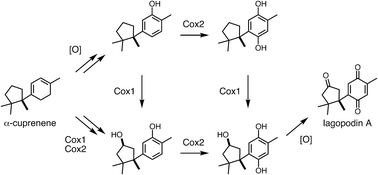Biosynthesis of lagopodins in mushroom involves a complex network of oxidation reactions†
Abstract
Use of the ku70-deficient strain of Coprinopsis cinerea enabled confirmation within the native context of the central role the sesquiterpene synthase Cop6 plays in lagopodin biosynthesis. Furthermore, yeast in vivo bioconversion and in vitro assays of two cytochrome P450 monooxygenases Cox1 and Cox2 allowed elucidation of the network of oxidation steps that build structural complexity onto the α-cuprenene framework during the biosynthesis of lagopodins. Three new compounds were identified as intermediates formed by the redox enzymes.

- This article is part of the themed collections: Chemical Biology in OBC and Biosynthesis


 Please wait while we load your content...
Please wait while we load your content...